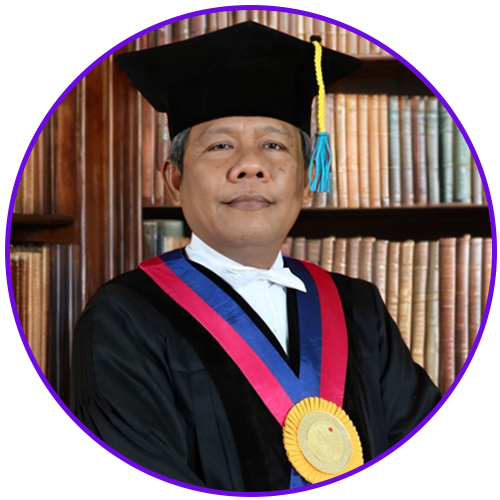Accredited in

GENERAL WRITING INSTRUCTIONS
- Signed Letter of Originality form originally (scan the document after signed) [Download Letter of Originality].
- Signed Copyright Transfer Agreement (CTA) form originally (scan the document after signed) [Download Copyright Transfer Agreement]
SPECIFIC WRITING INSTRUCTIONS
1. The Original Research has the following systematic arrangement:
Title should be concise but informative, as far as possible in no more than 12 words.
Abstract written in English, do not exceed 250 words, containing elements of background, material and methods, results and conclusions.
Keywords maximum of 6 (six) words or phrases, written after the abstract in each languages, alphabetically ordered. As far as possible avoid using keywords from the title.
Running title is about 7 (seven) words.
Introduction consists of the background, research objectives, problem formulation and benefits. The background includes four main ideas, namely: problem statement, problem scale, problem chronology and research approach. Contains a description of the facts and expectations for the completion of the research. Described based on concepts built from references in the literature. The research question and/or hypothesis (if any) in the introduction should not write in the form of points or should not be numbered.
Materials and Methods in details so that other author could do the similar research with the written method in the article. Materials and methods are brief descriptions of the research design, how to conduct research and mention the materials/objects and tools used.
Results and Discussion compared with other research that ever conducted or discuss based on the theoretical framework that is used in the research. Use up-to-date references such as books that published in the last ten years and journal articles that published in the last five years (except the reference that being recommended by the reviewer in this field).
Tables are made without vertical lines (use only lines at the top and bottom of the table as well as for separating heading from the main table), with table title placed before the table, numbered in Arabic numerals (Table X), and have to be referred in the text. The description of the table is placed after the table; it must be concise but clear enough so that the table separately can be understood without referring to the text. The table along with the title and description are placed after the References.
Figures presented are only those that support the findings of the study, and not restatement of data from tables in the form of figures. When resulted data in the form of figure is more informative, interesting or significant, presentation of data in table form is not required. Figure title is placed after the figure, numbered in Arabic numerals (Figure Y), and have to be referred in the text. The description of the figure is placed under the title of the figure; it must be concise but clear enough so that the figure separately can be understood without referring to the text. Image (in JPEG format) is sent in separate file with minimum resolution 720dpi. The title and description of the figure are placed after the References.
Conclusion in one paragraphs without using the bullet points or number.
Approval of Ethical Commission have to be stated (number and institution) if the manuscript is constructed based on a research using live animals.
Acknowledgements are delivered to the research funders (state the name, number and recipient name of the grant, if applicable), and to those who have helped carry out the research.
References Arranged according to the Harvard reference format 1 style. Researchers should use reference management applications (e.g. Mendeley, Endnote, Zotero, etc.). References must be valid, published within the previous 15 (fiveteen) years and contain at least 70% primary references (journals, books and patent documents). Unpublished sources, such as manuscripts in preparation and personal communication, are not acceptable as references. Only those sources cited in the text should appear in the reference list. The names of authors must be written in a consistent manner throughout the text. The numbers and volumes of journals must be cited, with edition, publisher, city and page numbers of textbooks also included. References to downloaded internet sources must include the time of access and web address. All original articles should include at least 15 references.
Starting from Vol 8 No 1 March 2024, the Journal of Parasite Science uses The Harvard reference format 1 Style referencing writing system.
Citation format for journal articles:
Template: Lastname, First name initial.middle name initial. (Year) ‘Title of article: subtitle of article’, Name of journal, Volume(issue/season etc), pp.(page number-page number), Available at: URL doi..
Three Author(s):
In text: (Modabbernia, Meshgi and Kinsley, 2024)
More than Three Author(s):
In text: (Unal et al., 2024)
Citation format for proceedings:
Template: Lastname, First name initial.middle name initial. (Year). ‘Title of article: subtitle of article’, in Name of journal proceedings, Publisher. Available at: URL DOI
Three Author(s):
In text: (Suprihati, Yunus, and Wijaya, 2022)
More than Three Author(s):
In text: (Wardhana, et al., 2024)
Citation format for textbooks:
Template: Lastname, First name initial.middle name initial. (Year) Title of textbook. Edition (if applicable). Place published: Publisher. Series and volume number (if applicable) or Available at: URL
Three Author(s):
In text: (Hastutiek, P., Yunus, M. and Sunarso, A, 2022)
More than Three Author(s):
In text: (Suwanti et al., 2022)
Citation format for electronic publications (web page):
Template: Lastname, First name initial.middle name initial. (Year). Title. Publisher. Available at: URL (Acecssed: month date, year)
In text: (Melchor, 2022)
Citation format for thesis and dissertations:
Template: Lastname, First name initial.middle name initial. (Year) Title of thesis/dissertation. Degree statement (eg PhD thesis, MSc thesis, MA thesis). Name of the University or degree awarding body. If accessed online: DOI or Available at: URL (Accessed: date)
In text: (Gautam, 2014)
Citation format for patents:
Template: Lastname, First name initial.middle name initial. (Year). Title of paten. Authorising organitation. Paten number. Available at: URL – If online
In text: (Mufasirin, Suwanti and Supriyanto, 2015)
Citation format for report:
Template: Name of issuing body. (Year) Title. Place of publication (if in print). Publisher (if in print). (Series) - if applicable. Available at: URL - if online
In text: (Dinas Peternakan dan Kesehatan Hewan Nusa Tenggara Barat, 2017)
2. Review Article and Case Reports:
Journal of Parasite Science receives quality and interesting case reports and review articles with topics included in the scope of this journal. All reports are peer-reviewed as is applied to original articles. All instructions are the same as for the original research.
Manuscripts are written not exceeding 4500 words or 12 pages are included in Figures and Tables.
Preparation of manuscripts for Title and Identity of the author as same as the guidelines of original research.
Abstract: Consisting of at least 100 words and a maximum of 250 words
The composition of the manuscript includes an Abstract, Introduction, Material and Methods, Results and Discussion, Conclusion, Acknowledgments, and References.




Author's Guideline Letter of Originality Human Ethics Animal Ethics Template of Article Copyright Transfer Agreement
| Semua | Sejak 2019 | |
|---|---|---|
| Kutipan | 306 | 290 |
| indeks-h | 8 | 7 |
| indeks-i10 | 4 | 4 |







Call for Paper to be Publish in Vol. 9 No. 2 September 2025 and Vol. 10 No. 1 March 2026 | No Fee required for Manuscript Submission and No fee required for Article Processing Calling Parasitology Experts: Become an Editorial Board Member or Reviewer for the Journal of Parasite Science! Call for Paper to be Publish in Vol. 9 No. 2 September 2025 and Vol. 10 No. 1 March 2026 | No Fee required for Manuscript Submission and No fee required for Article Processing Calling Parasitology Experts: Become an Editorial Board Member or Reviewer for the Journal of Parasite Science! Call for Paper to be Publish in Vol. 9 No. 2 September 2025 and Vol. 10 No. 1 March 2026 | No Fee required for Manuscript Submission and No fee required for Article Processing Calling Parasitology Experts: Become an Editorial Board Member or Reviewer for the Journal of Parasite Science! Call for Paper to be Publish in Vol. 9 No. 2 September 2025 and Vol. 10 No. 1 March 2026 | No Fee required for Manuscript Submission and No fee required for Article Processing Calling Parasitology Experts: Become an Editorial Board Member or Reviewer for the Journal of Parasite Science! Call for Paper to be Publish in Vol. 9 No. 2 September 2025 and Vol. 10 No. 1 March 2026 | No Fee required for Manuscript Submission and No fee required for Article Processing Calling Parasitology Experts: Become an Editorial Board Member or Reviewer for the Journal of Parasite Science! Call for Paper to be Publish in Vol. 9 No. 2 September 2025 and Vol. 10 No. 1 March 2026 | No Fee required for Manuscript Submission and No fee required for Article Processing
